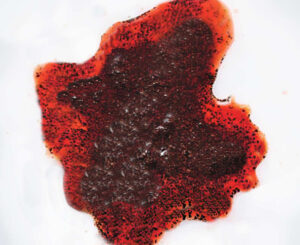
This article was updated on May 30th, 2023
Vomiting in dogs is one of the most common complaints from owners that bring their pets to see me. Vomiting is unpleasant for everyone, and this includes your furry friend. Vomiting can be a mild inconvenience or a signal that something is very seriously amiss with your dog. Understandably, seeing specks or clots of blood in your dog’s vomit can be even scarier.
In my practice, I have seen many dogs with specks or clots of blood in their vomit. Common causes have included toxins, infections, gastric dilation volvulus (GDV), foreign body obstructions, hemorrhagic gastroenteritis (HGE), parasites, and others. Because the causes are wide-ranging, having your dog seen by their veterinarian as soon as possible is essential.
In this article, we will review what vomit with specks of blood looks like, top reasons & what to do.
What Does Dog Vomit with Specks or Clots of Blood Look Like?
1. Mucus with Specks of Blood: below is a picture showing dog vomit with small specks of blood.

2. Coffee Ground Appearance Blood Clots: Below is a picture of dog vomit with blood clots looking like coffee ground:

What are the Most Likely Causes of Dogs Vomiting with Specks of Blood?
Let’ review now the most common causes of bloody vomit in dogs:
1. Broken blood vessels
Forceful or prolonged vomiting may result in the rupture of vessels in the esophagus or throat. This will appear as typically red blood or blood clots in the vomit.
Clinical signs may include:
– Vomiting, whether once or multiple times
– Mild lethargy
– Stomach pain
Treatment: There is no specific treatment for the broken blood vessels. However, the underlying cause must be determined and treated.
2. Intestinal parasites
Parasites that feed on blood from within the gastrointestinal tract may also result in bloody vomit. The vomit may be red-tinged or have clots in it.
Clinical signs may include:
– Vomiting,
– Weight loss,
– Bloated appearance to the abdomen, and
– Poor hair coat.
Treatment: A fecal test for parasites must be run and any parasites found should be treated accordingly.
3. Infections
Both bacteria and viruses may result in blood in your dog’s vomit.
Clinical signs may include:
– Vomiting and stomach pain.
– Los off appetite
– Lethargy
– Fever
Treatment: The treatment for these infections will vary depending on severity and whether or not the infection is caused by a bacterium or a virus. Many dogs will require hospitalization with IV fluids for rehydration as well as fever lowering medications.
4. Foreign Body Obstruction
If your dog eats a foreign object, for example, a toy, ball, sock, corn cob, or another object, it may become lodged in their stomach. The irritation and inflammation may result in red blood and mucus being vomited.
Clinical signs may include:
– Vomiting,
– inappetence,
– abdominal tension and pain, and
– reluctance to eat.
Treatment: Some cases of intestinal or gastric foreign body obstruction may resolve with aggressive IV fluid therapy. Many others require a surgery to remove the object.
5. Hemorrhagic gastroenteritis
This complex disease may sometimes result in bloody vomit. The vomit tends to have large black blood clots resembling raspberry jam. Typically the dog also has bloody diarrhea.
Clinical signs may include:
– Vomiting,
– Reluctance to eat, and
– Raspberry jam appearing diarrhea.
Treatment: HGE will be treated with iv fluid therapy, antibiotics, pain medications, and anti-emetics.
6. Toxins
Many toxins, including rat poison, will decrease your dog’s ability to clot and may lead to bloody vomit with frank red blood in it.
Clinical signs may include:
– Vomiting,
– Weakness / lethargy
– Bruising,
– Seizures,
– Coughing,
– Bleeding from the mouth, eyes, nose, or anus.
However, it is important to note that early in the course of the illness, when the dog’s life can still be saved, there may be minimal to no signs.
Treatment: The treatment for toxicity will be tailored specifically to the toxin ingested.
7. Gastric Dilation Volvulus
Due to the extreme retching usually seen with a GDV, these dogs may vomit up a frothy foam with blood specks in it. This is an absolutely life-threatening emergency, and these dogs must be taken to a veterinarian immediately.
Clinical signs may include:
– Vomiting,
– Retching, and
– Collapse
– Restlessness and
– Bloated abdomens.
Treatment: GDV must be treated immediately. The dog’s stomach may be decompressed with a stomach tube or via a trocar. Surgery is required to repair the stomach.
8. Cancer
Unfortunately, cancer is very prevalent in our canine companions. A cancerous mass in the stomach or gastrointestinal tract can lead to specks or clots of blood in the dog’s vomit. The location of the tumor and how long the blood has been in the Gi tract will dictate the appearance of the bloody vomit.
Clinical signs may include:
– Inappetence,
– Vomiting,
– Weight loss, and
– Loose stool.
Some cancers exhibit few to no signs early in the disease process.
Treatment: If your dog is diagnosed with a gastrointestinal tract cancer, there may be treatment options including surgery, chemotherapy, immunomodulation, and radiation.
Chat with a veterinarian online now about your dog’s vomit with blood:
When in doubt, you can chat with a licensed veterinarian online now to discuss your dog’s situation, for just $1. Connect now with a veterinarian, or start a chat below:
Rates may differ for those residing outside the U.S. You’ll have access to a vet for 7 days.
Can Vomit with Specks of Blood in a Dog Be Treated at Home?
Vomit with specks of blood may be mild and transient, but it can also easily be life-threatening. Additionally, a small amount of blood may be an early warning sign that needs to be acted upon quickly to avoid massive bleeding later. Any time you see blood in your dog’s vomit, you should promptly seek veterinary care for them.
Should I Be Worried About My Dog?
Anytime a dog is vomiting, with bright red blood or even just a little bit of blood, it is a cause for concern. Though a virus or eating something foreign could cause small amounts of transient vomiting in a dog, it is also often the first sign that your dog is very ill. If there is blood in the vomit, known as hematemesis,” the issue could be simply a broken blood vessel in the esophagus or a sign of a very serious issue. Only your veterinarian can tell what may be causing the vomiting in your dog and how serious it is, so you should make an appointment for them to be seen right away.
Treatment and Costs
Depending on the cause, your dog may need hospitalization and treatment. These treatments may include intravenous fluids and injectable medications. Appropriate treatment cannot begin until a diagnosis is reached. This will include x-rays, blood work, and other testing. The cost of this workup and treatment at your veterinarian can be $500 to $1500+, depending on the severity of your dog’s condition.
What Are the Signs That My Dog’s Situation is an Emergency?
Vomiting specks of blood is always a cause for concern, and you should consult your veterinarian. Some signs signal an absolute emergency, and these dogs should be taken immediately to their veterinarian or the nearest emergency hospital. These signs include:
- Large amounts of blood – Severe blood loss can be fatal if left untreated and may require a blood transfusion.
- Young dogs and small dogs – These pups have less blood overall and tend to be more fragile. Parvovirus is also common in puppies and needs emergency care.
- Lethargic or non-responsive dog – If your dog is unwilling or unable to get up, they should be taken to an emergency veterinarian immediately.
- Severe retching or intractable vomiting– If your dog is repeatedly retching or vomiting multiple times in an hour, they should be quickly taken to the nearest veterinary hospital.
What Will Happen at The Veterinarian?
When you take your dog that is having specks of blood in their vomit to the veterinarian, they will quickly determine the severity of the issue and begin stabilizing your dog if necessary. This may consist of IV fluids and pain medications. Diagnostics will be needed to determine the cause of the bloody speckled vomit. These will include:
-Basic blood work (CBC, Chemistry, UA)
-Parasite testing
-Blood clotting tests
-X-rays
-Abdominal ultrasound
Once your veterinarian has determined what is causing the bloody vomiting in your dog, they will put together a treatment plan. This may consist of IV fluids, medications, blood transfusions, and surgery.
Questions Your Veterinarian May Ask and What You Should Bring to the Veterinarian
It is imperative that you give your veterinarian as complete and thorough of a history as you can. Dogs cannot talk, and therefore your veterinarian relies on you for this information. I recommend writing down timelines with details of your dog’s illness as well as taking pictures of any vomit. Make sure to inspect the dog’s environment for toxins and missing objects. If any toxins are suspected, please either bring the packaging with you or take a picture of the ingredients. Attempt to determine how much was possibly ingested.
The Prognosis for Dogs who Have Bloody Vomit with Small Clots or Small Amounts of Blood
In general, with appropriate medical care, the prognosis for dogs with specks of blood in their vomit is good. This prognosis varies widely depending on the underlying cause, of course. Vomiting caused by a dietary indiscretion with no foreign body obstruction, resulting in a broken vessel, has a great prognosis. However, foreign body obstructions, parvovirus, cancer, and GDV may all be fatal. These conditions will require surgery or aggressive treatment in most cases.
Related post:
Blood Tests for Dogs: How Much Do They Cost?
Disclaimer: This website's content is not a substitute for veterinary care. Always consult with your veterinarian for healthcare decisions. Read More.


Be the first to comment